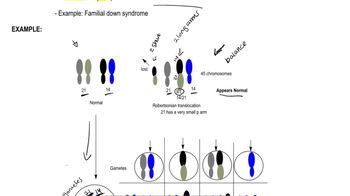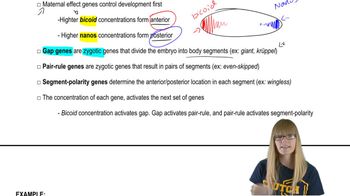Describe the origin of cultivated American cotton.
Table of contents
- 1. Introduction to Genetics51m
- 2. Mendel's Laws of Inheritance3h 37m
- 3. Extensions to Mendelian Inheritance2h 41m
- 4. Genetic Mapping and Linkage2h 28m
- 5. Genetics of Bacteria and Viruses1h 21m
- 6. Chromosomal Variation1h 48m
- 7. DNA and Chromosome Structure56m
- 8. DNA Replication1h 10m
- 9. Mitosis and Meiosis1h 34m
- 10. Transcription1h 0m
- 11. Translation58m
- 12. Gene Regulation in Prokaryotes1h 19m
- 13. Gene Regulation in Eukaryotes44m
- 14. Genetic Control of Development44m
- 15. Genomes and Genomics1h 50m
- 16. Transposable Elements47m
- 17. Mutation, Repair, and Recombination1h 6m
- 18. Molecular Genetic Tools19m
- 19. Cancer Genetics29m
- 20. Quantitative Genetics1h 26m
- 21. Population Genetics50m
- 22. Evolutionary Genetics29m
6. Chromosomal Variation
Chromosomal Mutations: Aberrant Euploidy
Problem B.11c
Textbook Question
The most common reason a physician might recommend that a woman have maternal serum screening and a karyotype analysis is concern that her fetus may have Down syndrome. Go to the OMIM website at www.ncbi.nlm.nih.gov/omim and look up Down syndrome (OMIM 190685).
Summarize what is known about the location and genes found within the DSCR.
 Verified step by step guidance
Verified step by step guidance1
Step 1: Understand the context of the problem by recognizing that Down syndrome is a genetic disorder caused primarily by trisomy of chromosome 21, and that the Down Syndrome Critical Region (DSCR) is a specific segment on chromosome 21 believed to contain genes contributing to the characteristic features of the syndrome.
Step 2: Visit the OMIM website at www.ncbi.nlm.nih.gov/omim and enter the OMIM number 190685 to access detailed information about Down syndrome, including genetic and molecular data.
Step 3: Locate the section or references within the OMIM entry that describe the DSCR, noting its chromosomal location on chromosome 21, typically within the region 21q22.1 to 21q22.3.
Step 4: Identify and list the key genes found within the DSCR as described in the OMIM entry, such as DYRK1A, DSCR1 (RCAN1), and others, and understand their proposed roles in the development of Down syndrome phenotypes.
Step 5: Summarize the information by explaining that the DSCR is a critical segment on chromosome 21 containing multiple genes whose overexpression due to trisomy contributes to the clinical features of Down syndrome.
 Verified video answer for a similar problem:
Verified video answer for a similar problem:This video solution was recommended by our tutors as helpful for the problem above
Video duration:
2mPlay a video:
Was this helpful?
Key Concepts
Here are the essential concepts you must grasp in order to answer the question correctly.
Down Syndrome Critical Region (DSCR)
The DSCR is a specific segment on chromosome 21 believed to contain key genes responsible for the characteristic features of Down syndrome. It is a focus for research because duplications in this region are linked to the syndrome's phenotypes, helping to pinpoint which genes contribute to developmental and cognitive effects.
Recommended video:
Guided course

Robertsonian Translocations
Maternal Serum Screening and Karyotype Analysis
Maternal serum screening tests measure specific proteins and hormones in a pregnant woman's blood to assess the risk of chromosomal abnormalities like Down syndrome. Karyotype analysis involves examining the fetus's chromosomes to detect trisomy 21, confirming the diagnosis by identifying an extra copy of chromosome 21.
Recommended video:
Guided course

Maternal Effect
Genes Located Within the DSCR
Several genes within the DSCR, such as DYRK1A, DSCR1, and APP, are implicated in Down syndrome. These genes influence brain development, cell signaling, and other biological processes, and their overexpression due to trisomy 21 contributes to the syndrome's clinical features.
Recommended video:
Guided course

Segmentation Genes
Related Videos
Related Practice
Textbook Question
669
views


